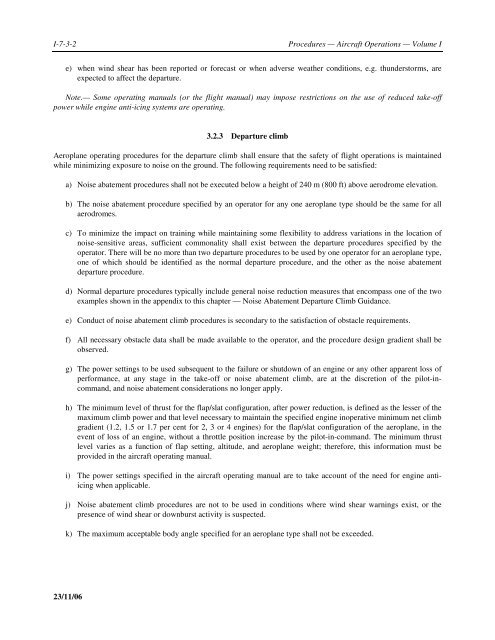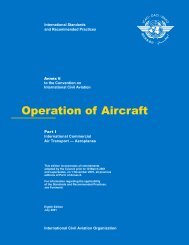Aircraft Operations
Doc 8168 Aircraft Operations, Volume I Flight Procedures
Doc 8168 Aircraft Operations, Volume I Flight Procedures
- No tags were found...
Create successful ePaper yourself
Turn your PDF publications into a flip-book with our unique Google optimized e-Paper software.
I-7-3-2<br />
Procedures — <strong>Aircraft</strong> <strong>Operations</strong> — Volume I<br />
e) when wind shear has been reported or forecast or when adverse weather conditions, e.g. thunderstorms, are<br />
expected to affect the departure.<br />
Note.— Some operating manuals (or the flight manual) may impose restrictions on the use of reduced take-off<br />
power while engine anti-icing systems are operating.<br />
3.2.3 Departure climb<br />
Aeroplane operating procedures for the departure climb shall ensure that the safety of flight operations is maintained<br />
while minimizing exposure to noise on the ground. The following requirements need to be satisfied:<br />
a) Noise abatement procedures shall not be executed below a height of 240 m (800 ft) above aerodrome elevation.<br />
b) The noise abatement procedure specified by an operator for any one aeroplane type should be the same for all<br />
aerodromes.<br />
c) To minimize the impact on training while maintaining some flexibility to address variations in the location of<br />
noise-sensitive areas, sufficient commonality shall exist between the departure procedures specified by the<br />
operator. There will be no more than two departure procedures to be used by one operator for an aeroplane type,<br />
one of which should be identified as the normal departure procedure, and the other as the noise abatement<br />
departure procedure.<br />
d) Normal departure procedures typically include general noise reduction measures that encompass one of the two<br />
examples shown in the appendix to this chapter — Noise Abatement Departure Climb Guidance.<br />
e) Conduct of noise abatement climb procedures is secondary to the satisfaction of obstacle requirements.<br />
f) All necessary obstacle data shall be made available to the operator, and the procedure design gradient shall be<br />
observed.<br />
g) The power settings to be used subsequent to the failure or shutdown of an engine or any other apparent loss of<br />
performance, at any stage in the take-off or noise abatement climb, are at the discretion of the pilot-incommand,<br />
and noise abatement considerations no longer apply.<br />
h) The minimum level of thrust for the flap/slat configuration, after power reduction, is defined as the lesser of the<br />
maximum climb power and that level necessary to maintain the specified engine inoperative minimum net climb<br />
gradient (1.2, 1.5 or 1.7 per cent for 2, 3 or 4 engines) for the flap/slat configuration of the aeroplane, in the<br />
event of loss of an engine, without a throttle position increase by the pilot-in-command. The minimum thrust<br />
level varies as a function of flap setting, altitude, and aeroplane weight; therefore, this information must be<br />
provided in the aircraft operating manual.<br />
i) The power settings specified in the aircraft operating manual are to take account of the need for engine antiicing<br />
when applicable.<br />
j) Noise abatement climb procedures are not to be used in conditions where wind shear warnings exist, or the<br />
presence of wind shear or downburst activity is suspected.<br />
k) The maximum acceptable body angle specified for an aeroplane type shall not be exceeded.<br />
23/11/06












